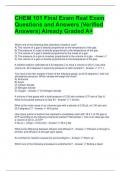Exam (elaborations)
CHEM 101 Final Exam Real Exam Questions and Answers (Verified Answers) Already Graded A+
- Course
- Institution
CHEM 101 Final Exam Real Exam Questions and Answers (Verified Answers) Already Graded A+ Which one of the following best describes Charles's Law? A) The volume of a gas is directly proportional to the temperature of the gas. B) The pressure of a gas is directly proportional to the temperature of...
[Show more]



